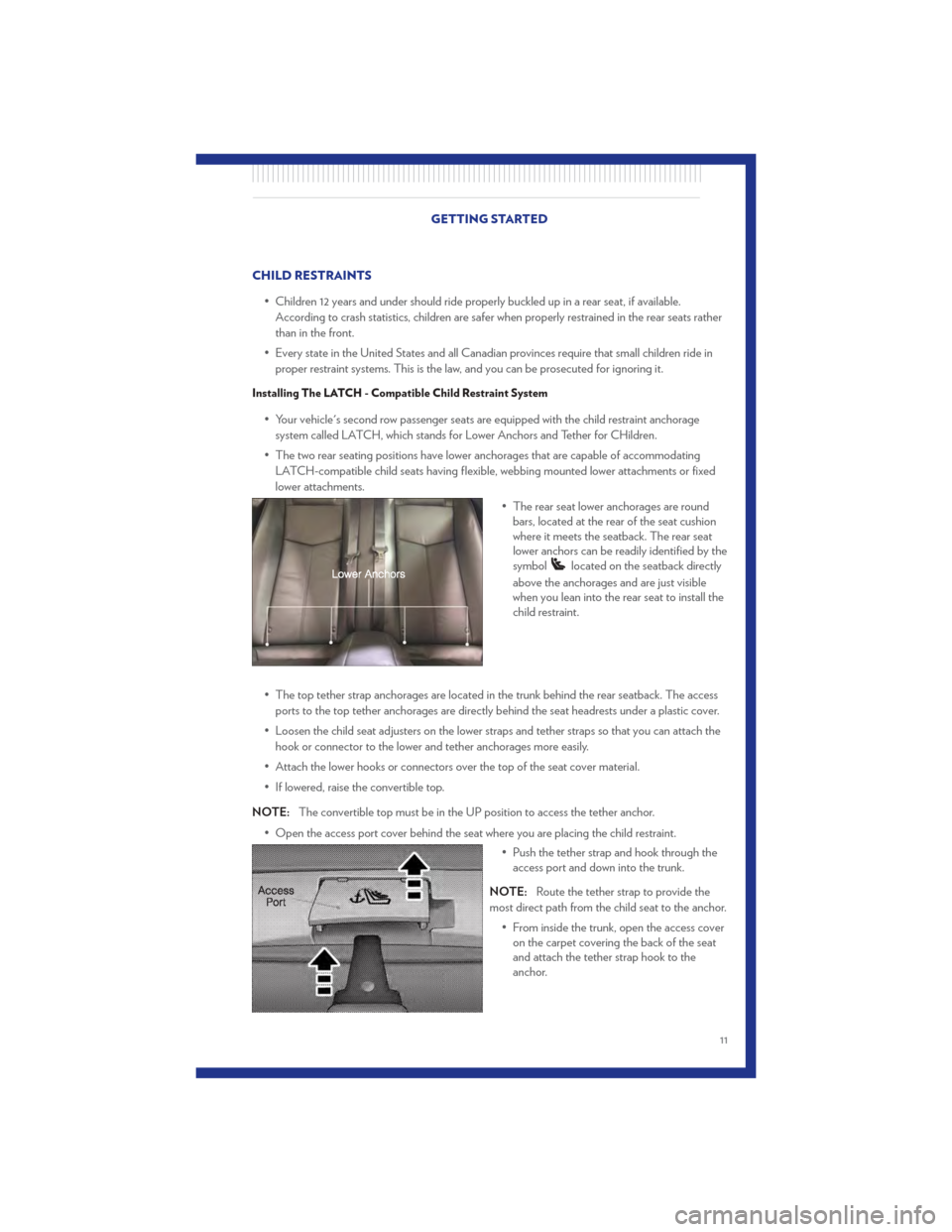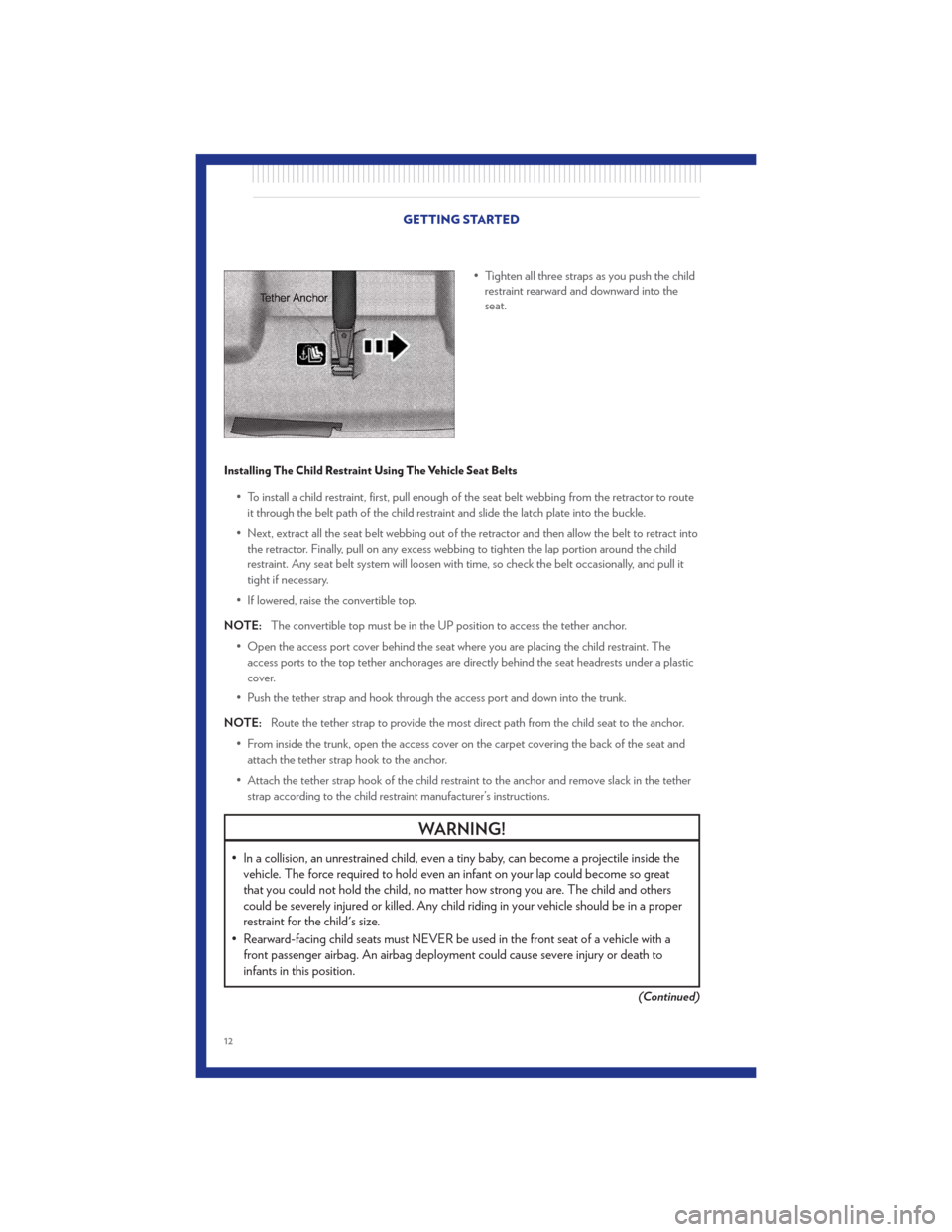headrest CHRYSLER 200 CONVERTIBLE 2011 1.G User Guide
[x] Cancel search | Manufacturer: CHRYSLER, Model Year: 2011, Model line: 200 CONVERTIBLE, Model: CHRYSLER 200 CONVERTIBLE 2011 1.GPages: 84, PDF Size: 2.9 MB
Page 13 of 84

CHILD RESTRAINTS• Children 12 years and under should ride properly buckled up in a rear seat, if available.According to crash statistics, children are safer when properly restrained in the rear seats rather
than in the front.
• Every state in the United States and all Canadian provinces require that small children ride in proper restraint systems. This is the law, and you can be prosecuted for ignoring it.
Installing The LATCH - Compatible Child Restraint System
• Your vehicle's second row passenger seats are equipped with the child restraint anchoragesystem called LATCH, which stands for Lower Anchors and Tether for CHildren.
• The two rear seating positions have lower anchorages that are capable of accommodating LATCH-compatible child seats having flexible, webbing mounted lower attachments or fixed
lower attachments.
• The rear seat lower anchorages are roundbars, located at the rear of the seat cushion
where it meets the seatback. The rear seat
lower anchors can be readily identified by the
symbol
located on the seatback directly
above the anchorages and are just visible
when you lean into the rear seat to install the
child restraint.
• The top tether strap anchorages are located in the trunk behind the rear seatback. The access ports to the top tether anchorages are directly behind the seat headrests under a plastic cover.
• Loosen the child seat adjusters on the lower straps and tether straps so that you can attach the hook or connector to the lower and tether anchorages more easily.
• Attach the lower hooks or connectors over the top of the seat cover material.
• If lowered, raise the convertible top.
NOTE: The convertible top must be in the UP position to access the tether anchor.
• Open the access port cover behind the seat where you are placing the child restraint. • Push the tether strap and hook through theaccess port and down into the trunk.
NOTE: Route the tether strap to provide the
most direct path from the child seat to the anchor.
• From inside the trunk, open the access coveron the carpet covering the back of the seat
and attach the tether strap hook to the
anchor.
GETTING STARTED
11
Page 14 of 84

• Tighten all three straps as you push the childrestraint rearward and downward into the
seat.
Installing The Child Restraint Using The Vehicle Seat Belts
• To install a child restraint, first, pull enough of the seat belt webbing from the retractor to route
it through the belt path of the child restraint and slide the latch plate into the buckle.
• Next, extract all the seat belt webbing out of the retractor and then allow the belt to retract into the retractor. Finally, pull on any excess webbing to tighten the lap portion around the child
restraint. Any seat belt system will loosen with time, so check the belt occasionally, and pull it
tight if necessary.
• If lowered, raise the convertible top.
NOTE: The convertible top must be in the UP position to access the tether anchor.
• Open the access port cover behind the seat where you are placing the child restraint. The access ports to the top tether anchorages are directly behind the seat headrests under a plastic
cover.
• Push the tether strap and hook through the access port and down into the trunk.
NOTE: Route the tether strap to provide the most direct path from the child seat to the anchor.
• From inside the trunk, open the access cover on the carpet covering the back of the seat and attach the tether strap hook to the anchor.
• Attach the tether strap hook of the child restraint to the anchor and remove slack in the tether strap according to the child restraint manufacturer’s instructions.
WARNING!
• In a collision, an unrestrained child, even a tiny baby, can become a projectile inside thevehicle. The force required to hold even an infant on your lap could become so great
that you could not hold the child, no matter how strong you are. The child and others
could be severely injured or killed. Any child riding in your vehicle should be in a proper
restraint for the child's size.
• Rearward-facing child seats must NEVER be used in the front seat of a vehicle with a front passenger airbag. An airbag deployment could cause severe injury or death to
infants in this position.
(Continued)
GETTING STARTED
12